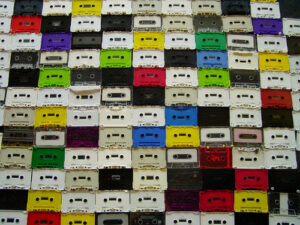
Wired’s Epicenter blog recently compiled “10 Weird Ways to Distribute Music.” But, really, the list might be more accurately characterized as “10 Unique Ways,” rather than weird. Seems that some popular indie bands like Dirty Projectors are now releasing some albums on cassette again, making the format #8 on Wired’s list. At least blogger Eliot Van Buskirk had the good taste of linking to my somewhat tongue-in-cheek 2007 post titled, “Next Big Retro Thing: The Cassette Revival.”
Of course, distributing new music on cassettes stands out only because the format’s been largely abandoned by the mainstream. I emphasize new music because I’ve certainly seen cheap cassette compilations of country classics and oldies still turn up at truck stops and dollar stores. Cassette-only labels were an underground music fixture in the 80s and 90s due to both the low cost of doing limited edition releases and the relative ubiquity of cassette players.
While mostly overtaken by CD-Rs and downloadable MP3s, cassette labels have survived. Plustapes is a Chicago-based label putting out new independent music on cassette each in limited editions of a hundred or so. Earlier this year the music blog Expressway to My Skull compiled a list of active cassette-only labels and places to find them.
Perhaps the greatest advantage of releasing music on cassette is that it’s possible to record and duplicate albums entirely in the analog domain easily and cheaply without a computer. If you want to get fancy you can find a cassette four-track at a thrift or pawn shop so you have more recording and editing flexibility. Then get a dubbing deck and you’re set. It doesn’t have to be about analog fetishism — it can simply be about being cheap.
Perhaps the enduring charm of the cassette has to do with its fundamental nature as a recording medium that is very accessible, but imposes real practical limits on its duplication. It’s easy for nearly anyone to duplicate several dozen cassettes using inexpensive dubbing decks, but quantities of much more than that require commercial duplicating services. Like ‘zines, cassettes can be a near-mass medium, where you can reach hundreds with a work that the creator still fashioned and touched with her own hands.
Now that we can take for granted the ability to reach a nearly unlimited audience with a perfectly-duplicable MP3 file, there’s something to be said for a sound medium that can’t be had by anyone with a ‘net connection, that didn’t roll off an assembly line. It doesn’t have to be a case of internet vs. cassette; I think there’s room for both to coexist, even in symbiosis.
Leave a Reply